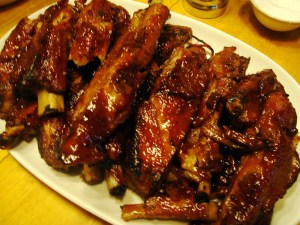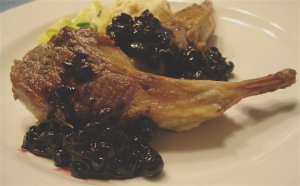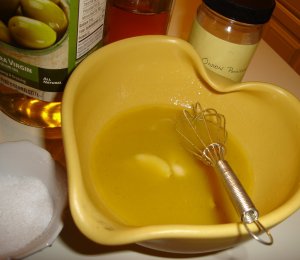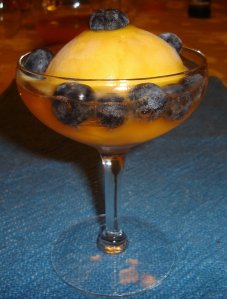Welcome to WordPress.com. This is your first post. Edit or delete it and start blogging!
Hello world!
August 21, 2009Green Beans with Saffron & Cumin Seed
August 1, 2009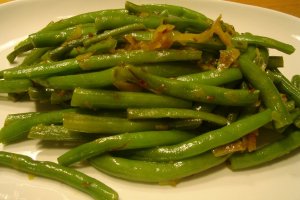
Espana. One of my favorite places in the world. From the awe inspiring architecture of Barcelona’s La Sagrada Familia to the natural beauty of Madrid’s Royal Botanical Gardens and the revered Museo del Prado to the rousing and sensual flamenco of the Andalusia region, Spain is steeped in a culture that is gracefully yet fiercely passionate and rich in tradition. And the food… oh, the food! For me, the siren call of Spanish cuisine lies in the use of saffron, the cornerstone seasoning of many traditional Spanish dishes like paella. Adding a pinch of saffron to your food imparts a gorgeous yellow color and a very distinct taste, kind of like sweet honey with a metallic edge. Saffron is quite pricey but it’s well worth the investment because you use only a small bit each time and the flavor pay-off is huge. Buy only a small amount at a time and store in a tightly covered container in a dark, dry place.
In this recipe, saffron, cumin seeds, shallots and a small splash of sherry vinegar dress sauteed green beans with the characteristic flavors of Spain. These green beans pair well with Smoky Orange Grilled Chicken or Citrus Roasted Pork Shoulder. Vegetarians can make a whole meal by adding a couple cups of cooked chickpeas after the green beans are finished cooking. Increase the cumin seed and vinegar to 1 or 1 1/2 teaspoons each, depending on your taste.
GREEN BEANS with SAFFRON & CUMIN SEED
1 pound of green beans, cleaned and trimmed
1 tablespoon olive oil
1 shallot, thinly sliced
1 big pinch of saffron
1/2 teaspoon cumin seed (if you can’t find the seeds then substitute ground cumin)
1/4 teaspoon kosher salt
1/2 cup water
1 teaspoon sherry vinegar
Heat olive oil in a large saute pan over medium heat.
Add shallots and cumin seeds. Saute for a few minutes until the shallots soften. (Be careful because a couple of the cumin seeds might pop out of the pan as they heat up.)
Add the green beans and stir to coat the beans completely with the oil and cumin seeds. Saute for a few minutes.
Crumble the saffron over the green beans. Sprinkle with the salt.
Add the water.
Cover and steam until the green beans are crisp-tender, about five minutes.
Uncover and allow any water still in the pan to evaporate over the heat.
Remove from heat. Sprinkle the vinegar over the green beans and mix well.
Serve hot or at room temperature.
Serves 4 as a side dish.
Lamb Chops with Blueberry Sauce
July 30, 2009By now we’ve all heard about the amazing antioxidant benefits of eating blueberries so we can agree that, at a mere 83 calories per cup, blueberries are amazingly good for you. And you and I have chatted before about how easy it is to use frozen blueberries in your baking when you can’t find fresh. We’ve also talked about pairing blueberries with champagne and sorbet for a simple yet elegant dessert. So now let’s turn our attention to using blueberries in a savory recipe that combines blueberries, herbes de provence (for a little French flair, ooh la la) and red wine to create a sauce for tender lamb chops. The sweet-tart flavor of the blueberries and the floral aroma of the herbes de provence gently tame the slightly gamy flavor of lamb.
This dish is really easy to prepare so it’s great for everyday dinners but still chic enough for a dinner party. If you cook this for a dinner party, you can prepare the lamb and the sauce up to an hour ahead of time, leaving out the butter at the end. Hold in a low oven with the door slightly ajar until ready to serve. I like to preheat the oven to 225 degrees and then turn it off before I put in the lamb to wait for my guests. Make sure that the oven isn’t too hot because you don’t want to accidentally overcook the lamb, which should be cooked to medium if you follow the recipe directions. Swirl the butter into the sauce right before serving.
LAMB CHOPS WITH BLUEBERRY SAUCE
8 lamb loin chops or rib chops
1/2 teaspoon kosher salt
1/4 teaspoon black pepper
2 teaspoons olive oil
1 shallot, finely minced
1/3 cup red wine
1/2 pint blueberries, washed and any stems removed
1 teaspoon herbes de provence
1 tablespoon cold unsalted butter
Season lamb on all sides with salt and pepper.
Heat olive oil over medium heat in a large saute pan.
Saute lamb on both sides until browned, about two and a half minutes per side. If you prefer a more well done chop, add another minute per side. Use your good judgment.
Remove lamb from pan and place on a plate.
Add shallots to pan and saute until translucent, stirring frequently.
Add blueberries and saute until the fruit begins to break down, about five minutes.
Add the red wine and herbes de provence.
Raise heat and bring to a quick boil.
Lower heat to medium-low. Add lamb back to the pan and simmer gently for a few minutes.
Swirl in the cold butter to thicken the sauce.
To serve, arrange the chops on a platter and spoon the sauce over the top.
Serves 4.
Curry Lime Grilled Chicken
July 17, 2009
The first time I ate Indian food was in the West End of London during my study abroad program. My friend Moshe was mortified, rightfully so, that I had somehow managed to be on this planet for twenty years without ever tasting a samosa so he treated me to lunch on a sunny afternoon, but not before we tried to wheedle our way into the closed theatre where our hero Harold Pinter was rehearsing his (then) new play Ashes to Ashes. We were unsuccessful in our attempt to gaze upon our beloved Harold and we had to content ourselves with merely being in the same building as such a powerful creative force. We trudged off to the restaurant, slightly despondent but also laughing really hard because the guard on duty clearly thought we were stalkers or, at the very least, crazy Americans.
The name of the restaurant where we ate now escapes me but I will always remember my first taste of chicken curry. What a revelation! I grew up eating bland food and my family rarely ate out in restaurants so ethnic food wasn’t part of my life. But I was hooked after that first bite. I like to think that was the point where I became a lot more adventurous in my eating and open to tasting foods from other cultures. Curry Lime Grilled Chicken is my humble ode to the magnificent flavors of Indian cooking. There’s nothing quite like the first time you have a culinary epiphany but this recipe is my reminder of that great afternoon I spent with a friend way back when we were young and convinced that all the world was our stage.
CURRY LIME GRILLED CHICKEN
4 pounds bone-in, skin-on chicken pieces
4 garlic cloves, chopped
juice and zest of 3 limes
3 tablespoons vegetable oil
2 tablespoons good quality mild curry powder
1 teaspoon cumin
1 teaspoon ground fenugreek
Place chicken pieces in a large zip-top bag or in a large, wide bowl.
Whisk together remaining ingredients and pour over chicken. Turn the chicken around in the marinade to ensure that each piece is coated.
If using a zip-top bag, gently press out excess air before closing. If using a bowl, cover tightly with plastic wrap. Marinate chicken in refrigerator at least 4 hours and up to 48 hours. Turn the chicken a couple of times to allow even marinating.
Heat grill to medium. Grill chicken, about eight minutes per side for larger pieces like the breast. Smaller pieces like the wing will take a few minutes less.
Tastes great hot, at room temperature or cold.
Serves 4 generously.
Food, Inc. Now Playing
July 3, 2009There’s a lot of buzz right now about a little movie called Food, Inc. that takes an inside look at the effects of modern food production in the United States. Directed by Robert Kenner, Food, Inc. draws upon the works of many writers, including Eric Schlosser (Fast Food Nation) and Michael Pollan (The Omnivore’s Dilemma). Variety magazine called it a “ civilized horror movie for the socially conscious, the nutritionally curious, and the hungry” so be forewarned that viewing this movie might spoil your next meal. That said, this movie raises numerous important issues that all of us, as socially conscious, health conscious and eco-conscious citizens, should know about.
Check out the trailer:
My Connecticut neighbors, you’re in luck! Food, Inc. is now playing at Real Art Ways Cinema in Hartford, starting tonight and continuing through July 9, 2009. Showtimes are at 7pm or 9pm and tickets are cheap. Click here for more info. I’ll probably go check out the movie sometime this week so drop me a line at revelandfeast@gmail.com if you want to come along.
If you don’t live in the Hartford area then you can look here to find a showing near you.
If you can’t make it to the movie, then please pick up a copy of the companion guide, also entitled Food, Inc. And I have to brag- the book was edited by my brilliant father-in-law Karl Weber!!
Nominated for the Black Weblog Awards!
June 30, 2009Hurray! Revel & Feast has been nominated for the Black Weblog Awards in five categories:
Best Food Blog
Best New Blog
Best Writing in a Blog
Blog to Watch
Best Microblog
Voting is open now from June 20 – July 25 and finalist voting is available from August 1 – August 31. To vote for Revel & Feast, click on this:
Thanks for your support!!
House Vinaigrette
June 29, 2009I started making my own salad dressings a few years ago when I opened the fridge one day and realized there were at least ten half-empty bottles of dressing languishing on the bottom shelf. I have a real commitment problem when it comes to salad dressing. I buy a new dressing every other time I hit the grocery store because I am seduced by the sexy packaging of just about every product in the condiment aisle and because I apparently suffer from some sort of amnesia that prevents me from remembering that I already have bottles upon bottles waiting forlornly in my fridge. I bring home my newest salad companion, pour it lavishly all over my salads for a few days and then promptly forget about it by the time my next shopping trip rolls around on the weekend. So the end result is the aforementioned army of salad dressing bottles sitting in my fridge that will never be used up before their expiration dates, which is wasteful to say the least. I’m really trying to be less wasteful and more creative in the kitchen so I’ve started whisking together my own dressings, making just enough for a few salads at a time. This minimizes waste, ensures freshness and allows me to switch up my dressings on a whim.
I prefer dressings of the vinaigrette persuasion because I like my salad dressed sharply with the tang of vinegar and the smoothness of olive oil. My house vinaigrette recipe uses white balsamic vinegar, a personal favorite because of its great balance between acidity and sweetness. White balsamic vinegar is much paler than traditional balsamic vinegar and has a lighter taster that marries well with all kind of salads. I love regular balsamic vinegar but sometimes it’s a bit too much for more delicate salads. This house vinaigrette tastes great as is but it’s also the perfect base for all kinds of herbs and seasonings so you can add a pinch of this or a dash of that to enhance whatever style of meal you’re making.
HOUSE VINAIGRETTE
4 tablespoons extra virgin olive oil
1 1/2 tablespoons white balsamic vinegar
1 teaspoon dijon mustard
1/2 teaspoon kosher salt
1/4 teaspoon onion powder
1/4 teaspoon sugar
1 garlic clove, crushed
Combine all ingredients in a small bowl. Allow to sit for for a few minutes to allow the garlic to infuse its flavor.
Remove garlic and whisk thoroughly before serving.
Makes scant 1/2 cup of dressing. Enough for 2 to 4 salads, depending on how wet you like your salad.
Flavoring Suggestions:
Italian Vinaigrette: Add 1 teaspoon dried basil and a pinch of thyme or oregano
Spanish Vinaigrette: Instead of white balsamic vinegar use sherry vinegar or red wine vinegar. Add 1/4 teaspoon smoked paprika and 1/4 teaspoon ground cumin.
French Vinaigrette: Increase sugar to 1/2 teaspoon. Add 1 teaspoon herbes de provence or 1 teaspoon tarragon and 1/4 teaspoon ground fennel.
Garlic Vinaigrette: Omit crushed garlic. Instead whisk in 1/2 to 1 teaspoon garlic paste, created by mashing a garlic clove with 1/4 teaspoon kosher salt until very smooth. Add 1/2 teaspoon dried parsley.
P.S. – Check out the beautiful yellow mixing bowl and mini whisk in the picture. My BFF Emily picked it up for me at a little place called Mark Klammer Pottery in upstate New York last year. This set has become my go-to tool for mixing up salad dressing in a flash. The heart shaped design is gorgeous and ingenious! The design is ergonomic so you can easily cradle the bowl with one hand by placing your thumb in the curved indent at the top of the heart, while whisking with the other. The little spout formed by the point of the heart allows you to serve and pour the dressing right out of the mixing bowl. Love it!
Broccoli Salad with Whole Grain Dijon & Dill Vinaigrette
June 17, 2009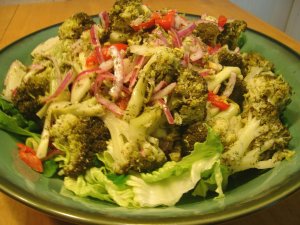
We celebrated my son’s 10th birthday a couple weekends ago. In between trying to wrap my head around the fact that my baby boy had reached the double digits and preparing the house for company, I tried to convince said baby boy that German potato salad would be a great dish to serve with his favorite Garlic Burgers. He did not agree. He might be only ten years old but he is very opinionated about food and made it very clear that potato salad of any kind was not acceptable. I tried to change his mind by pointing out that German potato salad has bacon in it (which he loves) but he did not give in. Although, he did suggest that we fry up some bacon to put on the burgers, a thought which I did seriously entertain. But then I went grocery shopping for the party and forgot to buy the bacon so that was that and no one had any bacon for their burgers. We finally agreed upon a marinated broccoli salad. I sort of couldn’t believe it. Given a choice between a potato salad with BACON and broccoli, my kid chose the broccoli. What can I say? Best. Kid. Ever.
This recipe makes enough for 10 because it was created for a party but you can cut the ingredients in half to serve 4 or 5 people if you want. This salad keeps incredibly well in the fridge so you might want to make a full recipe and eat the leftovers throughout the week. The broccoli only gets better the longer it marinates in the vinaigrette.
BROCCOLI SALAD with WHOLE GRAIN DIJON & DILL VINAIGRETTE
1/2 cup extra virgin olive oil
1/3 cup white balsamic vinegar
1 teaspoon kosher salt
1 teaspoon crushed garlic
1 tablespoon whole grain Dijon mustard
2 teaspoons dill
2 pounds broccoli florets
1 cucumber, seeded and chopped
1 small red onion, thinly sliced
12 ounce jar roasted red peppers, drained and chopped
1 romaine heart, shredded
1/2 cup coarsely chopped parsley
2 lemons
Whisk together oil, vinegar, salt, garlic, mustard and dill in a small bowl.
Blanch broccoli florets in boiling salted water until crisp-tender, about 3 minutes. Drain and shock in an ice bath to preserve color and to stop cooking. Drain again.
Combine the broccoli, cucumber, red onion and red peppers in a large bowl. Toss with the vinaigrette. Refrigerate for at least 4 hours and preferably overnight.
Right before serving, place the shredded lettuce and parsley in a large serving platter. Pour the marinated vegetables over the lettuce.
Zest the two lemons and add the zest to the salad.
Juice the lemons and pour the juice over the salad.
If desired, toss gently before serving.
Serves 10.
Champagne Float
June 14, 2009If I had to choose only one beverage to drink for the rest of my days then I would choose champagne. I swoon for the effervescent headiness of all those tiny bubbles dancing around in my mouth. Most people drink champagne only on special occasions but how many truly special occasions do you celebrate in a year? Maybe five? Six? However many you can count, why limit yourself to champagne toasts at only the most celebratory events? Let’s have bubbly every day! We’re grown-ups so who can stop us? I’m in if you’re in.
Here’s my take on the classic root beer float, updated and made elegant with champagne, sorbet and fresh berries.
CHAMPAGNE FLOAT
1 bottle dry champagne
2 pints of peach, mango or lemon sorbet
1 pint of blueberries, strawberries or blackberries
6 champagne glasses (the ones shaped like a saucer, not a flute)
Use an ice cream scoop to place a generously sized ball of sorbet into each champagne glass.
Divide the berries equally between the glasses. If the strawberries are large then cut them into halves or quarters.
Pour in enough champagne to almost reach the top of the glass.
Serve immediately.
Serves 6
